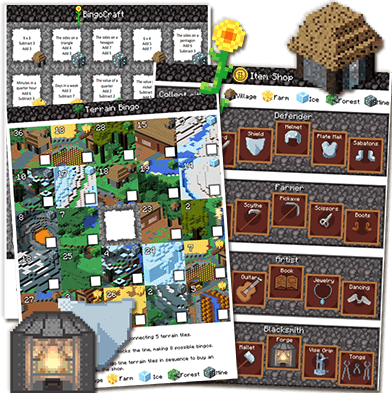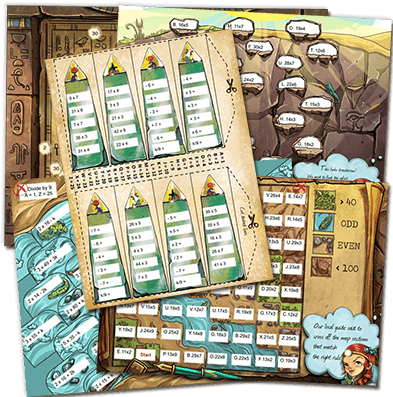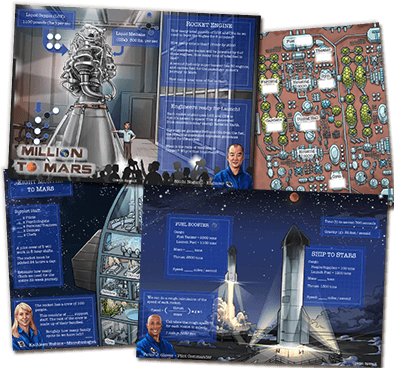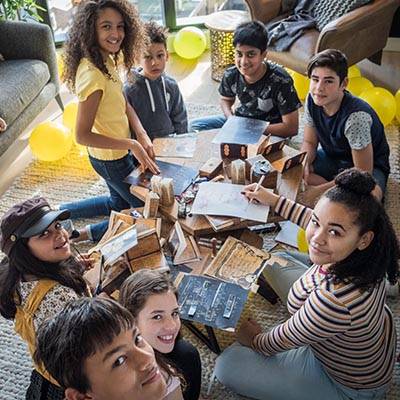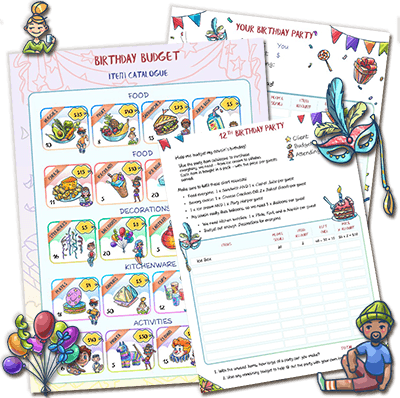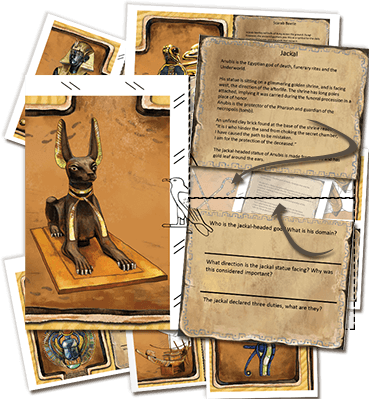Mental Maths Made Easy
Check out our free worksheet options and tips on making your students successful!

Why Mental Maths Isn’t Going Away

Looking for a more engaging worksheet game? Try 'Adventure Egypt'!
With calculators, computers and smartphones, some wonder about the benefit of mental maths. After all, this skill enables students to quickly and accurately make calculations in their head. But can’t technology do that faster for you anyway? So what is the benefit of mental calculations in today’s world?
Keeps Your Focus on the Bigger Maths Problem
Lacking mental calculation skills can be a big roadblock to success in higher maths, and STEM lessons further on. As students advance in mathematics, simple calculations are still present. And, students who must use a calculator for these calculations can lose sight of the bigger problem they're trying to solve. Imagine that you visit another country. Wanting to speak the local language, but not fluent yet, you bring along a translation tool. Unfortunately, while you’re searching for the right verb conjugation, you may forget what you meant to say next! Forgetting even a single word could change the whole meaning of your sentence. Forgetting a step in a higher maths problem will lead to incorrect answers too. With mental calculation skills, students can focus their mental energy on the higher level maths they're trying to learn.
Improve Estimation Skills
Doing calculations quickly in their heads can boost students' estimation abilities. This allows students to double-check the answers given by their calculators. For example, if students are multiplying 189 by 21, they might estimate that the answer will be around 4000 (200 x 20). If their calculator reports an answer of 2,079, they’ll realize that they must have hit a wrong button. Then, they can redo the calculation and get the right answer.
Strengthen Mathematical Flexibility and Creativity
The problems our students will face in their careers will undoubtedly require creativity and flexibility. Number sense skills can help our students become mental calculation champions! And, it will spark creativity and flexible thinking at the same time! Number sense is our ability to recognize the patterns in how numbers can work together. Using these pattern-based shortcuts, students can minimize the mental load of doing calculations. Not only is it fun, but it teaches students that there are many ways to get to the right answer - an important part of STEM learning!
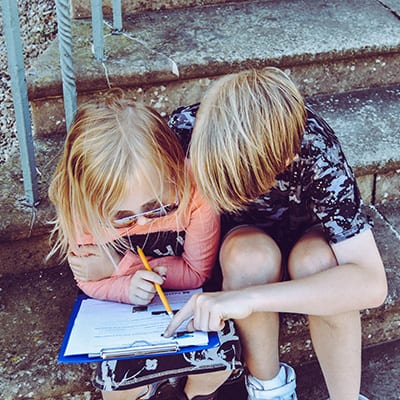
Make Your Students Addition and Subtraction Superstars

Good news - we've got even more free math worksheets for you here! (they work great for your homeschool lessons too)
Practice makes perfect! And, there are some calculations that are just best to memorize. For example, students should memorize 1) how to add zero, 2) how to count on by 1, 10 or 100, and 3) how to double single-digit numbers. Dot plates can be useful to practice these mental calculations. Simply explain to students which operation you want to practice with them. Then, randomly show them a dot card, and they give the answer. For example, if you’re practicing doubles, and you show them a 6-dot card, they should respond with 12.
Another great tool is the 10-frame. This framework helps students identify what numbers add up to 10. For example, you can share a ten frame with three dots in it. Students can then count the empty spaces to see that 7 more dots would complete the frame and give you 10 total. With this knowledge, students can use the commutative property of addition to quickly identify and add by tens. For example, adding 8 + 9 + 2 + 5 + 1 + 5 is the same as (8 + 2) + (9 + 1) + (5 + 5).
Finally, our students are really going to shine when they use decomposition in their mental calculations. For example, students can swap tricky numbers like 4, 6, or 9 with “friendly” numbers that are easier to work with, like 5’s and 1’s, 10’s, 100’s. When these nearby friendly numbers are decomposed, the calculation becomes easy. For example, if students need to add 99 to 276, they may recognize that 99 is the same thing as the friendly number 100, minus 1. So, they can add 100 to 276, and then subtract 1 from that answer.
Make Your Students Multiplication and Division Dynamos
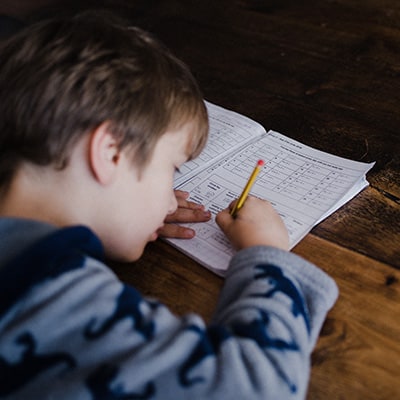
Build off your students' multiplication and division skills with this engaging worksheet game - that teaches students to budget, the FUN way!
Don't put away those dot cards just yet! There is also a level of calculation with multiplication and division that requires memorization. For example, multiplying 0 through 10, 100, 1000, etc. should be memorized. Flash cards and dot cards are invaluable classroom and homeschool resources that can help students to practice these skills until they are second nature.
With these facts memorized, students can then learn strategies to maximize their effectiveness! The commutative property helps students multiply a series of numbers quickly. For example, 4 x 13 x 5 can be solved by multiplying the 4 and 5 together first to get 20. Then students can reduce the problem to 20 x 13, a much simpler proposition.
Decomposition is another strategy that can simplify the calculation for students. For example, 20 = 2 x 10, so we could also write 20 x 13 as 2 x 10 x 13. Again, using the commutative property, we can do 2 x 13 first to get 26, and then we get 26 x 10 for a total of 260.
Knowing that multiplying by one doesn't change an answer is another powerful trick. For example, 1/2 x 2 = 1. So, students can multiply a problem by 1/2 and 2 without changing the answer. For example, we can multiply 5 x 240 by 1/2 and 2. Then, we can use the commutative property to get (5 x 2) x (240 x 1/2). This simplifies to 10 x 120, giving us 1200.
Make it a Game and Learning Takes Off

Flashcards and boring worksheets simply won’t cut it! Repetitive practice is necessary to master these skills, but it doesn't have to be dull. You just need some go-to games to keep students engaged in the classroom, and during their homeschool lesson:
"Which Doesn’t Belong" Number Talk
Use a simple 4-square frame like in the “One of These Things... Activity” worksheet linked below. Fill each square with a different number or equation. Then, challenge students to identify one of the four options that they feel doesn’t belong in the set and explain why. There is no wrong answer to this exercise, which makes it a great opportunity for a number talk! As a class, let students share their answers and thinking. This type of discussion is perfect for developing everyone’s number sense.
"How Many Ways" Number Talk
In this talk, challenge students to see how many ways they can come up with as a class for solving a given problem. Share one problem at a time. Then, students take turns sharing different strategies they used to solve the problem. For example, with the problem 38 + 47, students might solve by doing a) 30 + 40 + 8 + 7 or b) 35 + 3 + 47 or c) 40 - 2 + 47. Consider some friendly competition too! Big groups can compete to see who comes up with the highest number of different strategies. Each new method shared is a new tool in their maths toolbelt!
Discover the Rule
In this game, provide a series of numbers or equations to students. Then, students work in small groups to determine the rule. For example, students could be given the list: 21, 9, 12, 15. They then determine the numbers are all multiples of 3. Or students could be given 12 + 18, 7 + 13, 5 + 25, 16 + 14, 1 + 29, etc. and have to determine that the ones places always add to ten. This can spark some great discussion!


Stand Up, Sit Down
Also a quick way to do a formative check for understanding, this game gets students moving! Share a problem, and have students stand up or sit down based on what they think the answer is. In a similar variation, if you had four answer options, students could move to one of the four corners of the room. Consider inviting a student from each answer choice to share their reason for choosing that answer. Then, give all students the option to change their answer choice. See if students can come to a consensus as a class on the correct answer.
Up to 101 Game
Turn a worksheet into a board game! All you need is a 1 to 100 chart, place markers and one 10-sided die (or two 6-sided dice). Each student's marker starts at 0, and students take turns rolling the dice. With each turn, students can choose to add, subtract, multiply or divide their place number on the chart by the number on the dice. The goal is to get to 101, but they cannot go over that number. For example, if a student starts at zero and rolls a 7, they can add 7 to 0 and go to the 7 spot. On their next turn if they roll an 8, they could go to 15 by adding or 56 by multiplying. If a student is on 99 and rolls a 9, they must subtract or divide, since they can't go over 101. The first student to land exactly on 101 wins!
Enjoy Free Resources To Make Your Students Shine!

Don’t let mental maths stress out your students, or you! And while we’re at it, let’s make it fun to learn!
Help yourself to the free worksheet options and resources below.
You'll be maximizing student learning, and they'll be having fun in no time!
Ready to Supercharge Your Classroom?
These printable activities gamify your lesson to thrill students into learning.
Students will solve immersive puzzles, overcome critical-thinking challenges, and pull together as a team.
Each worksheet is designed to maximise fun, develop key skills, and do all the hard prep-work for you.
Mental Math and Number Talk Resources (Frames, Dot Cards, Grids, Number Charts)
Mental Math and Number Talk Resources Grades K-2
Dot Cards with Corresponding Digits
Number Cards with Corresponding Ten Frame
Filled Tens Frames and Some More
One of These Things... Activity
Mental Math and Number Talk Resources Grades 3-5
Multiplication Dot Cards 3s through 9s
100s Grids Shaded
Base 10 Grid Papers
1-1000 Chart

